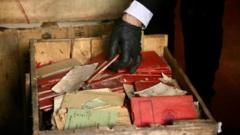In an intriguing turn of events, workers clearing out the basement of Argentina's Supreme Court stumbled upon wooden crates containing historical documents linked to Nazi Germany. This unexpected find came during preparations for the relocation of the court's archives to a newly established museum.
The documents date back to June 20, 1941, when they were sent from the German embassy in Tokyo to Argentina via 83 diplomatic pouches transported by a Japanese steamship. Argentine customs officials intercepted these pouches after discovering Nazi propaganda materials inside, raising concerns about maintaining the nation's neutrality during World War II.
Upon opening one crate, workers identified materials intended to promote Adolf Hitler's ideologies in Argentina during the war. The Supreme Court swiftly moved the crates to a secure location and contacted the Buenos Aires Holocaust Museum to assist in cataloging the contents, which include photographs and membership booklets adorned with swastikas.
Historians are hopeful that these documents will provide insights into the financial networks and international connections of the Nazis. According to court officials, the items were declared "personal effects" upon their arrival in Argentina, but the significant size of the shipment raised red flags among customs officials. Consequently, an Argentine judge seized all 83 pouches in September 1941 after the German embassy requested their return.
No definitive action was taken regarding the confiscated materials until after 1944 when Argentina severed ties with Axis powers. The crates remained dormant in the court's basement for decades. Following World War II, Argentina emerged as a sanctuary for several high-ranking Nazi officials such as Adolf Eichmann and Josef Mengele. In 2000, the nation officially apologized for its history of harboring Nazi war criminals.
The documents date back to June 20, 1941, when they were sent from the German embassy in Tokyo to Argentina via 83 diplomatic pouches transported by a Japanese steamship. Argentine customs officials intercepted these pouches after discovering Nazi propaganda materials inside, raising concerns about maintaining the nation's neutrality during World War II.
Upon opening one crate, workers identified materials intended to promote Adolf Hitler's ideologies in Argentina during the war. The Supreme Court swiftly moved the crates to a secure location and contacted the Buenos Aires Holocaust Museum to assist in cataloging the contents, which include photographs and membership booklets adorned with swastikas.
Historians are hopeful that these documents will provide insights into the financial networks and international connections of the Nazis. According to court officials, the items were declared "personal effects" upon their arrival in Argentina, but the significant size of the shipment raised red flags among customs officials. Consequently, an Argentine judge seized all 83 pouches in September 1941 after the German embassy requested their return.
No definitive action was taken regarding the confiscated materials until after 1944 when Argentina severed ties with Axis powers. The crates remained dormant in the court's basement for decades. Following World War II, Argentina emerged as a sanctuary for several high-ranking Nazi officials such as Adolf Eichmann and Josef Mengele. In 2000, the nation officially apologized for its history of harboring Nazi war criminals.






















